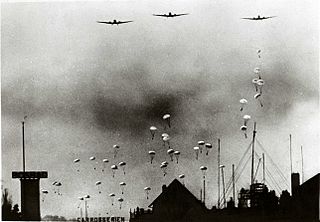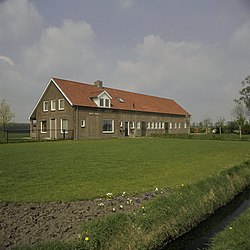
The Netherlands Armed Forces are the military services of the Kingdom of the Netherlands. The core of the armed forces consists of the four service branches: the Royal Netherlands Navy, the Royal Netherlands Army, the Royal Netherlands Air Force and the Royal Netherlands Marechaussee. The service branches are supplemented by various joint support organisations. In addition, local conscript forces exist on the Dutch Caribbean islands of Aruba (AruMil) and Curaçao (CurMil). These operate under the auspices of the Royal Netherlands Navy and the Netherlands Marine Corps. The armed forces are organisationally part of the Ministry of Defence.

RAF Fighter Command was one of the commands of the Royal Air Force. It was formed in 1936 to allow more specialised control of fighter aircraft. It served throughout the Second World War. It earned near-immortal fame during the Battle of Britain in 1940, when the Few held off the Luftwaffe attack on Britain. The Command continued until 17 November 1943, when it was disbanded and the RAF fighter force was split into two categories; defence and attack. The defensive force became Air Defence of Great Britain (ADGB) and the offensive force became the RAF Second Tactical Air Force. Air Defence of Great Britain was renamed back to Fighter Command in October 1944 and continued to provide defensive patrols around Great Britain. It was disbanded for the second time in 1968, when it was subsumed into the new Strike Command.

The Royal Netherlands Air Force is the military aviation branch of the Netherlands Armed Forces. It was created in 1953; its ancestor, the Luchtvaartafdeling of the Dutch Army, was founded in 1913. The aerobatic display team of the Royal Netherlands Air Force, active from 1979 until 2019, was the Solo Display Team.

The Swiss Air Force is the air component of the Swiss Armed Forces, established on 31 July 1914 as a part of the army and in October 1936 as an independent service.

The German Air Force is the aerial warfare branch of the Bundeswehr, the armed forces of Germany. The German Air Force was founded in 1956 during the era of the Cold War as the aerial warfare branch of the armed forces of then West Germany. After the reunification of West and East Germany in 1990, it integrated parts of the air force of the former German Democratic Republic, which itself had been founded in 1956 as part of the National People's Army. There is no organizational continuity between the current German Air Force and the former Luftwaffe of the Wehrmacht founded in 1935, which was completely disbanded in 1945/46 after World War II. The term Luftwaffe that is used for both the historic and the current German air force is the German-language generic designation of any air force.

The Royal Netherlands Army is the land branch of the Netherlands Armed Forces. Though the Royal Netherlands Army was raised on 9 January 1814, its origins date back to 1572, when the Staatse Leger was raised – making the Dutch standing army one of the oldest in the world. It fought in the Napoleonic Wars, World War II, the Indonesian War of Independence, and the Korean War and served with NATO on the Cold War frontiers in West-Germany from the 1950s to the 1990s.
The Royal Netherlands Army Artillery provides artillery support for the Royal Netherlands Army. It is divided into three corps, undertaking two roles: Korps Veldartillerie - Field Artillery and Korps Rijdende Artillerie - Horse Artillery. These two corps undertake the field artillery role. They are equipped primarily with the PzH2000 and were equipped with the M109 howitzer. Until 2013, one regiment retained the traditions of the Veldartillerie and one of the Rijdende Artillerie, with one assigned to each of the army's mechanised brigades.

NASAMS is a distributed and networked medium to long range surface-to-air missile defense system. NASAMS was the first surface-based application for the AIM-120 AMRAAM.

Soesterberg Air Base was a Royal Netherlands Air Force military air base located in Soesterberg, 14 kilometres (8.7 mi) east-northeast of Utrecht. It was first established as an airfield in 1911, and in 1913, the Dutch Army bought the field and established the Army Aviation Division.

Volkel Air Base is a military airbase used by the Royal Netherlands Air Force (RNLAF) - Dutch: Koninklijke Luchtmacht (KLu), and is located near the village of Volkel in North Brabant, Netherlands. It is home to two F-16 Fighting Falcon squadrons, No 312 and No 313. A third squadron formerly present at the airfield, No 311 Sqn, was officially disbanded on 27 September 2012. It also houses a maintenance, logistical, a base Squadron for the RNLAF, and also the 703rd Munitions Support Squadron, part of the 52nd Fighter Wing from the United States Air Force. Besides military use, a traumahelicopter operated by ANWB Medical Air Assistance on behalf of the Radboud University Nijmegen Medical Centre is based here. The Dienst Luchtvaart Politie also makes use of Volkel Air Base.

The battle for The Hague was a battle fought on 10 May 1940 during the Battle of the Netherlands. German Fallschirmjäger units were dropped in and around The Hague to capture Dutch airfields and the city itself.

Unternehmen Paula is the German codename given for the Second World War Luftwaffe offensive operation to destroy the remaining units of the Armée de l'Air (ALA), or French Air Force during the Battle of France in 1940. On 10 May the German armed forces (Wehrmacht) began their invasion of Western Europe. By 3 June, the British Army had withdrawn from Dunkirk and the continent in Operation Dynamo, the Netherlands and Belgium had surrendered and most of the formations of the French Army were disbanded or destroyed. To complete the defeat of France, the Germans undertook a second phase operation, Fall Rot, to conquer the remaining regions. In order to do this, air supremacy was required. The Luftwaffe was ordered to destroy the French Air Forces, while still providing support to the German Army.

The invasion of Belgium or Belgian campaign, often referred to within Belgium as the 18 Days' Campaign, formed part of the greater Battle of France, an offensive campaign by Germany during the Second World War. It took place over 18 days in May 1940 and ended with the German occupation of Belgium following the surrender of the Belgian Army.
Münster-Handorf Airfield is a former military airfield located in Germany about 5 miles east-northeast of Münster (Nordrhein-Westfalen); approximately 250 miles west of Berlin.

Flugabwehrraketengeschwader 1 or "Schleswig-Holstein" is a unit of the German Air Force based in Stadum and Husum, Northern Germany. The wing is equipped with the Patriot air defense missile system.
Second Allied Tactical Air Force was a NATO military formation under Allied Air Forces Central Europe tasked with providing air support to NATO's Northern Army Group (NORTHAG). 2 ATAF commanded all flying units based within its sector and all reinforcements flying into its sector, as well as ground-based radar systems and stations, air defense units and the airfields in its sector.

The Joint Ground Based Air Defence Headquarters or JtGBAD HQ was a joint (non-deployable), force-generating British military formation under the operational command of RAF Air Command, sitting under No.1 Group. It was formed circa 2000 and disbanded in 2019 in favour of 7th Air Defence Group.

The current structure of the Royal Netherlands Army is as follows:

7th Air Defence Group is a formation of the British Army and part of 3rd Division. It is responsible for all the army's ground based air defence assets. All of the organisation's subordinate units are drawn from the Royal Regiment of Artillery. Its headquarters are located at Baker Barracks, Thorney Island.

The Joint Ground-based Air Defence Command is a joint command of the Royal Netherlands Army, formed in 2012 after amalgamation of the Commando Luchtdoelartillerie of the Royal Netherlands Army and the Groep Geleide Wapens of the Royal Netherlands Air Force. The command is responsible for all ground-based air defence tasks and consists of both army and air force personnel. The DGLC employs an integrated layered air-defence approach featuring FIM-92 Stinger, NASAMS II and MIM-104 Patriot systems.



















